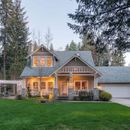Air barrier between attics?
Hi…we are in North Idaho one hundred miles south of the Canadian border near Coeur d’Alene in Climate Zone 5. We use AC in July & August and heating October to May.
I apologize in advance that this isn’t a brief question. I tried to condense this as much as possible, but it’s a complicated situation regarding energy efficiency strategy. I would really appreciate any help you might be able to offer.
Winter really got going this year around February 1 and we had a record 65 inches of snow in three weeks. We bought our home in March 2018 and this was our first winter in it, so naturally we got really bad ice dams, some water ingress and damage to our newly refinished floors in the upstairs master bedroom.
I am planning extensive energy upgrades with the objectives of avoiding future ice dams and water damage as well as improving energy efficiency and comfort.
My main question is whether I should isolate the three attics in the house which are now all open to each other. Details follow…
The house was built in 1991 and has not had any energy upgrades. The main part of the house is two-stories with a couple of large complex dormers, one for the bed in the master bedroom and one for the front porch (see photos). The two story part has a split pitch roof – 12/12 in the front and about 4/12 in the rear (essentially a large shed dormer). The rear of the house is single story and has the kitchen, dinning room and a nook. A single-story addition was added to the the rear in 2007 (includes two-bedrooms, laundry room, one bath, storage rooms, long hall). There are three attics over the single story part; over the two-story part; and the garage. Currently, there is no evidence of any mold or mildew growth anywhere in any of the three attics.
Attic inspections have revealed lots of energy shortcomings:
1. Inadequate insulation (blown-in cellulose) in both the original and addition areas. It appears to be an average of maybe R30, but there are lots of areas where the insulation is piled up. It is possibly windswept, poorly installed, or maybe moved by people who wired cable tv or security systems. There are several areas with bare ceiling sheetrock visible.
2. Maybe 10% of the cardboard rafter baffles are partially down
3. Inadequate ventilation around the second story dormers. Little air can enter near the dormers and the dormer front gable wall blocks air entry to the rafter bays.
4. Inadequate second story ridge ventilation – there are only two small turtle vents at the ridge (see aerial photo). The single story part has a continuous ridge vent which gets covered with heavy snowfall in this region.
5. Lots of can lights (IC, not AT) and ventilation fans (all fans vent outdoors).
6. Utility room combustion air in the ceiling opens to the single story attic – dumps heat into the attic.
7. An auxiliary gas-fired furnace plus supply and return ducts over the addition. The furnace and ducts are insulated, but that’s a lot of heat going into the attic when the furnace runs.
8. The three attics are open to each other and air can freely flow from one attic to the other. Moisture from warm cars in the garage can leak into the garage attic and flow to the attic over the rear single-story section. Air from the single story-attic can flow up to the second story attic through a huge opening where the return ducts go from the second story attic down to the utility room.
9. Very leaky and uninsulated hatches to both the first floor and second floor attics.
I have a big project ahead. The retrofit plan I’m thinking about is:
1. remove the cellulose insulation in the living areas; leave the existing cellulose over the garage.
2. enhance the second story ventilation inlets near the dormers on the front side of the house; I’m not sure how much inlet area we currently have or how to add inlet area (the water ingress happened near next to the large upper dormer on the left side). There is continuous soffit inlet on the rear shed dormer, so that inlet area is good.
3. add several roof exit vents near the second story ridge (looking at Ventilation Maximum cupola style vents that will not get covered by snow). I would balance inlet and exit area.
4. seal all electrical & plumping penetrations from living spaces to attics.
5 add can light covers sealed with foam.
6. replace can lights with Cree LED CR6 or LR6 retrofits and seal flanges to sheetrock.
7. add two inches closed cell foam over the ceiling sheetrock in both first floor and second floor attics; build up a 4 inch foam “berm” over the exterior perimeter top plates and up to the bottom of the rafter baffles
8. replace failing cardboard baffles with site-built foam or OSB baffles with 1-1/2 inch air space to roof sheathing; seal baffles to top plates
9. close off the utility room combustion air inlet to the attic.
10. seal the supply and return ducts (most of them are insulated flex)
11. possibly abandon the attic furnace and switch to wall electric heaters or add a ductless mini split system.
12. blow R60 fiberglass into the living space attics and add fiberglass to the garage to R39
13. tightly sealed and insulated attic hatches
Sorry for all that long-winded background! Yes, there are some questions and here is where I would really appreciate your advice:
1. Should I isolate the three attics from each other so they are each self-contained and do not communicate air between them? In other words, should I block air flow from the garage to the first floor attic and block air flow from the first floor attic to the second floor attic? The garage hovered near freezing this winter, even on the 5 degree outdoor temperature nights. But cars entering the garage bring in a lot of heat and moisture that flows up into both attics.
2. What’s the best approach to adding air inlets on the front of the house given the dormers?
3. We have 12 inch deep coffered ceilings in the single story dining room and kitchen areas; what is the best approach for insulating these?
4. Are there other energy considerations I should take into account? What am I missing?
Thanks in advance for any input or thoughts you might have on this! I want to spend my retrofit dollars wisely.
GBA Detail Library
A collection of one thousand construction details organized by climate and house part












Replies
Steve,
Lots of problems here. Your approach makes sense, but you may have bigger challenges than your realize.
If this were my house, I would certainly abandon the furnace and associated attic ductwork, and I would install ductless minisplits to handle the load now carried by the attic furnace.
If the dormers prevent all of the rafter bays from being vented, then you may have some rafter bays that need to be insulated using an unvented approach. If that's the case, you may have to remove roofing and roof sheathing, so that you can insulate some of the rafter bays with closed-cell spray foam from above.
Thanks, Martin. Appreciate your reply. I forgot to mention that there is a knee wall to the right of the porch dormer on the front 12/12 roof. These are (I think) 10 inch rafters over the knee wall area and the rafter bays have fiberglass batt insulation in them (kind of like a cathedral ceiling design). I don't recall if there is an air chute above the batts (I don't think there is). So it's even more complicated in this area.
If I have a cold, unconditioned attic, does it make sense to insulate individual rafter bays with CC foam as you suggest? Are you suggesting changing to a conditioned attic and insulate the entire roof sheathing assembly? I briefly considered that and rejected it.
What about the air communication between the three attics? Would I be better off isolating these to prevent airflow from 1) the garage attic to single story attic and then from 2) the single story attic to the second story attic? Right now, these are all open to each other.
Steve,
Q. "If I have a cold, unconditioned attic, does it make sense to insulate individual rafter bays with CC foam as you suggest?"
A. No. If the attic is vented, and you have a full-depth layer of R-49 insulation on the attic floor, there is no need for insulation in the rafter bays. Here's where things get tricky, however: if your attic lacks proper vent inlets because there is no air channel from the soffits to the attic, or if the rafter space is so compressed that there is no room to install a full-depth layer of R-49 insulation on the attic floor, you have to determine whether a different approach makes more sense.
Q. "Are you suggesting changing to a conditioned attic and insulate the entire roof sheathing assembly? I briefly considered that and rejected it."
A. It's one possible approach, but I'm not recommending it -- it's hard to say if that approach makes sense without a site visit. But it may still make sense to have a vented unconditioned attic above most of your house, while insulating a few rafter bays with an unvented approach.
Q. "What about the air communication between the three attics? Would I be better off isolating these to prevent airflow from 1) the garage attic to single story attic and then from 2) the single story attic to the second story attic? Right now, these are all open to each other."
A. I think this matter is mostly irrelevant. Your are focusing on the wrong issue. What you need are the following: (1) An air barrier between the interior conditioned space and the attic, and (2) R-49 insulation in direct contact with the air barrier. If you can get that, then the air mixing issue is irrelevant.
Ice dams are almost always a combination of conductive and convective heat loss. I bet folks on GBA get tired of me and Martin (and others) saying this but:
Be as airtight as you can; it's as important if not more so than the level of insulation you choose.
Peter
Thanks, Peter. I've read many papers and articles on GBA, JLC, and others about this problem and understand the importance of air sealing. That's why I'm going to the considerable expense of sucking out the existing cellulose over the living areas -- it's the only way to get access to do a good job of sealing. We are going to do individual leak seals, fill chases, drop ceiling soffits, recessed light covers, covers over ventilation fans, etc, then spray the 2 inches of CC foam over the ceiling sheetrock to really encapsulate and air seal it.
I just asked Martin this: should I isolate the three attics from one another? Right now, the garage attic is open to the single story attic and the single story attic has a huge hole into the second story attic around the return air ducts. This strikes me as a path for fire spread, for humidity spread, and for convective air flow to rise to the upper-most roof assembly. So I think it makes sense to isolate these from each other. What do you think?